Callibaetis Mayfly Nymph - Smith's All Natural
By Brian Smith
The early spring hatches of Callibaetis is
one of the year's most important to stillwater
fly fishers. The keys to successful outings
when this prolific species is hatching are
learning to anticipate and recognize the
signals of mayfly activity, and having a
suitable nymph pattern.
An emerging adult dun is recognized by its
sudden appearance on the water, joyfully
sailing along on the surface breeze for a
short distance, then flying off into shoreline
vegetation and tree cover from which they emerge
to mate. When mating is over, clouds of female
spinners engage in a flitting, bouncing dance
over the water's surface as they return to
deposit their eggs. When they've finished,
they drop to the water and die, their wings
spread out in spent configuration.
When trout are feeding on duns or spinners
on the surface, they provide wonderful dry
fly fishing. However, trout feed much more
prolifically on the nymphs as they rise
through the water column above the shoal,
often popping into adulthood while several
feet underwater. Consequently, fishing nymphs
during the emergence presents a much greater
opportunity for lots of action. One of the
first signs that there is a major migration
of nymphs to the surface is the appearance
of the first few duns.
In stillwaters, hatches of Callibaetis,
which can be heart stopping, take place in
the shallows, usually in less than six feet
of water. Therefore, these nymphs are best
fished with a floating line. Whether you're
fishing from a floating platform or from the
shore, it's best to cast into deeper water,
then retrieve toward shallower water, using
hand-twists of the fly line, interspersed by
quick jerks and 10-second pauses, as you lift
the fly from deep to shallow water. Strong
stillwater hatches of any migrating insect
are best fished this way.
Although Callibaetis nymphs are
abundant in many colors and sizes, four colors
are generally sufficient to handle all
situations olive gray, rusty brown, dark gray
and pale gray. Primary feathers dyed olive
gray and pale gray, natural goose and rust-colored
pheasant swordtail are excellent natural imitators
of a nymph's prominent gills. They are also
effective for constructing the thorax. Rusty
brown and dark gray nymphs work best in brown,
tannin stained waters, while pale gray and olive
gray are the most effective in clear waters,
rich with aquatic life.

Mature Callibaetis nymphs possess
two important features that cannot be overlooked
in representation a prominent three-pronged tail,
and a darkening of the thorax area. The tail is
tied one-half the body length with stiff feather
hackle or primary biots in the same color used
for the body.
When the nymph approaches maturity, the wing case
area darkens. This is best represented by a dark,
natural fiber, such as peacock herl, which also
adds texture and a light reflecting property to
the fly.
Dressing flies with natural materials adds another
critical ingredient that creates an overall
impression of a living insect tiny air bubbles.
Natural materials trap and hold these bubbles
more effectively than synthetic materials.
Natural Callibaetis Nymph Recipe:
Hook: Tiemco 200R, sizes #12 - #16.
Thread: Brown UTC.
Tail: 3 pheasant tail fibers.
Body: 3-4 pheasant tail fibers.
Wingcase: 3 strands of peacock herl.
Thorax: 4-5 pheasant tail fibers.
Legs: Grouse hackle, brown gray phase.
Tying Steps
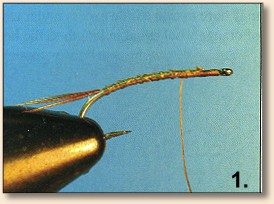
Step 1: Start tying the thread just
behind the hook eye. Choose a rusty
brown phase of pheasant sword for the
entire nymph pattern. Tie in the tail
so that it extends one half of the
body length past the bend.
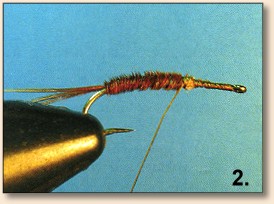
Step 2: Bind body fibers in at the bend,
wind them toward the eye of the hook for
2/3 of the shank length, and tie off.
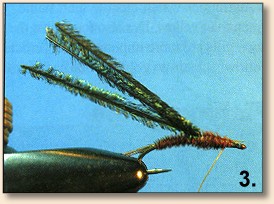
Step 3: Tie in the peacock herls for the
wing case at the point where you've tied
off the body, followed by the thorax material.
Wrap the thorax material up the shank to
just behind the eye.
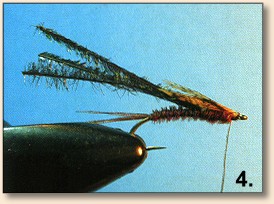
Step 4: Choose a brown phase grouse hackle,
spread the fibers, clip the tip from the
hackle, leaving 6-8 fibers on each side
of the feather. Tie the whole feather on
just behind the eye and over the thorax,
then spread the fibers to each side of
the fly.
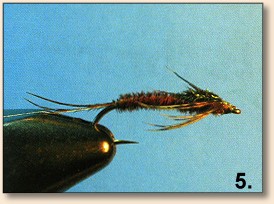
Step 5: Fold the wingcase over the thorax
and hackle, and bind it down and finish
the head. A final touch is to draw the
tail fibers gently between your thumbnail
and fingertip, which causes them to curve upward.
~ Brian Smith
Credits: This article is from the
Canadian Fly Fisher magazine. We appreciate use permission!
Our Man In Canada Archives
|

